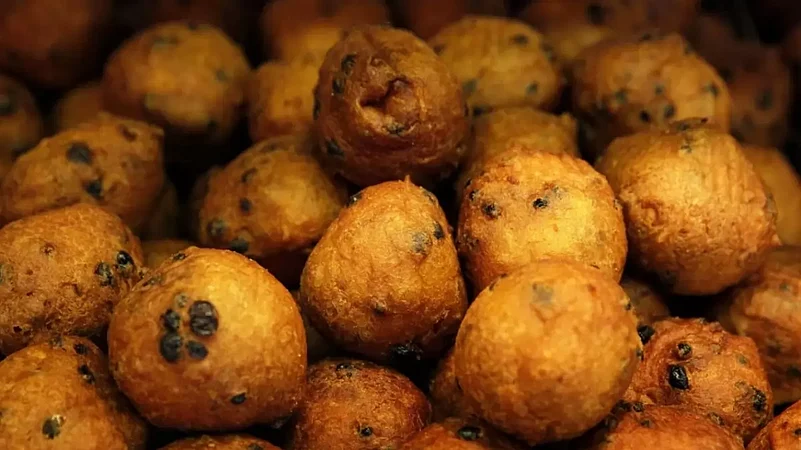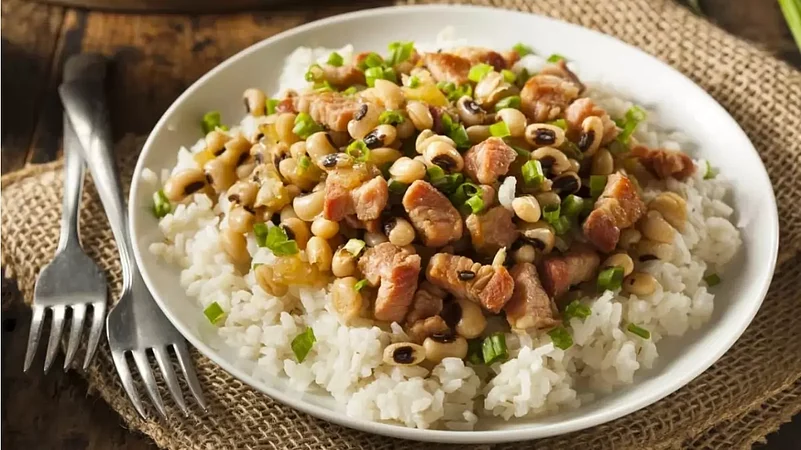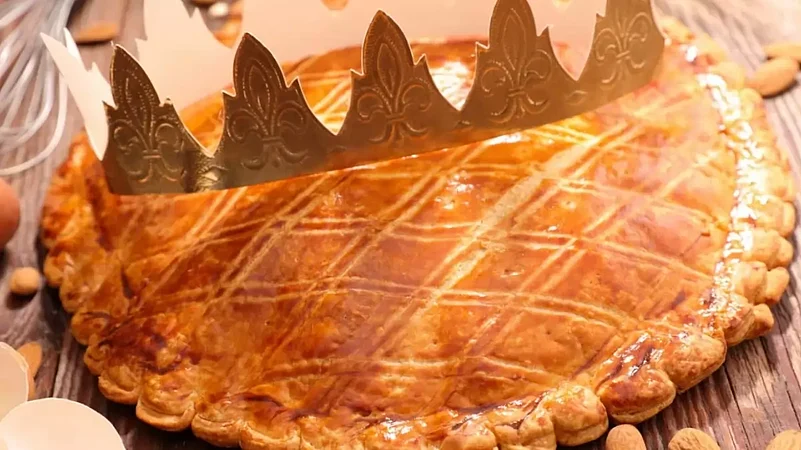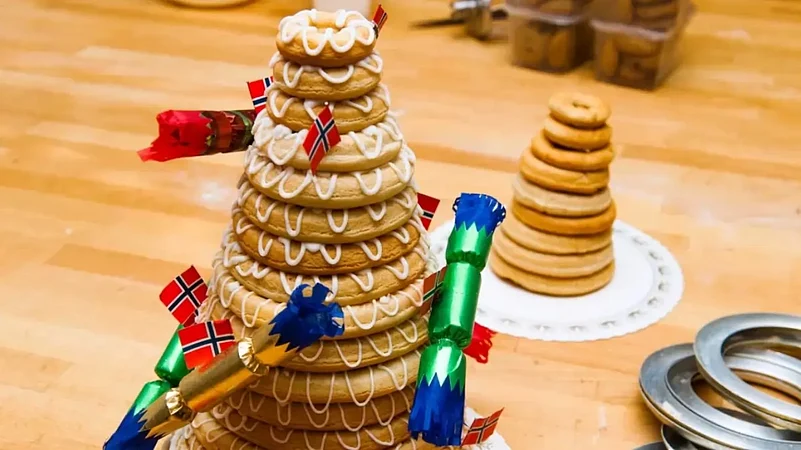New Year's Day is a time for new beginnings. If we go a step further (towards our hearts aka stomach), it is also a day for yummy (and lucky) food. Across the globe, you'll find a variety of special dishes and treats associated with the arrival of the new year. These include sweet desserts, long noodles signifying longevity, field peas symbolizing prosperity, herring representing abundance, and pigs symbolizing good fortune.
While the little details may differ, the overall concept remains consistent: Indulge in delicious food and rich beverages to welcome a year filled with prosperity.
Here are 10 traditional New Year's food customs from different parts of the world that are believed to bring good luck.
1. Twelve grapes in Spain

In Spain, it's a customary practice to watch a live broadcast from Puerta del Sol in Madrid during New Year's Eve. The gathering takes place in front of the square's clock tower to welcome the New Year.
Both the people in the square and those viewing from their homes participate in a unique annual tradition: as the clock strikes midnight, they consume one grape for each chime of the clock's bell. Some individuals even prepare their grapes in advance by peeling and removing the seeds to ensure a smooth experience when the clock strikes twelve.
This tradition originated at the beginning of the 20th century and is believed to have been initiated by grape growers in the southern region of Spain when they had an abundant grape harvest. Over time, this practice has spread to various Spanish-speaking nations.
2. Oliebollen in Netherlands

In the Netherlands, you can find fried balls known as "oliebollen," which are typically sold from street carts and enjoyed as a traditional treat on New Year's Eve and during special celebratory events. These oliebollen are reminiscent of doughnuts and are made by scooping dough mixed with currants or raisins into a deep fryer, followed by a generous dusting of powdered sugar.
In Amsterdam, keep an eye out for "Oliebollenkraams," small temporary stalls or trailers on the streets where you can purchase hot, freshly fried oliebollen.
3. Soba noodles in Japan

In Japanese households, it's a tradition to enjoy a dish called "toshikoshi soba," which consists of buckwheat soba noodles, at midnight on New Year's Eve. This ritual serves as a way to bid farewell to the departing year and welcome the arrival of the new one. Dating back to the 17th century, this custom involves consuming long noodles, symbolizing longevity and prosperity.
Another customary practice, known as "mochitsuki," involves friends and family coming together on the day before New Year's to pound mochi rice cakes. This process begins with washing, soaking, steaming, and then pounding sweet, glutinous rice until it becomes a smooth, malleable mass. Guests take turns shaping the mochi into small buns, which are later enjoyed as a dessert.
4. Hoppin’ John in American South

In the American South, a significant New Year's food tradition is "Hoppin' John." This dish features pork-flavored field peas or black-eyed peas, symbolizing coins, combined with rice. It's often served alongside cooked greens, like collards (chosen for their green color reminiscent of money), and cornbread (representing the color of gold). Hoppin' John is believed to bring good luck in the new year.
The history and name of this dish have various folkloric origins, but it primarily draws from African and West Indian culinary traditions and was likely introduced to North America by enslaved individuals. A recipe for Hoppin' John can be traced as far back as 1847 in Sarah Rutledge's book "The Carolina Housewife" and has since evolved through the contributions of home cooks and professional chefs over the centuries.
The dish is said to have received its name in Charleston, South Carolina, and has become an integral part of Lowcountry cuisine.
5. Tamales in Mexico

Tamales, which consist of corn dough filled with meat, cheese, and various delectable ingredients, then wrapped in a banana leaf or corn husk, are a staple at nearly every special occasion in Mexico. However, the holiday season holds a particularly special place for this beloved food.
During this time, it's a common tradition for groups of women to come together and collectively prepare hundreds of these little bundles. Each person typically takes charge of a specific aspect of the cooking process, resulting in a collaborative effort to make tamales that will be shared with friends, family, and neighbors. On New Year's, tamales are often served alongside "menudo," a soup made with tripe and hominy, known for its reputed effectiveness in alleviating hangovers.
6. New Year Special Cakes around the Globe

The tradition of having a New Year's cake is a widespread practice that transcends numerous cultures. Among these traditions, the Greeks celebrate with the Vasilopita, the French enjoy the gateau or galette des rois, Mexicans have the Rosca de Reyes, and Bulgarians savor the banitsa.
Most of these cakes are typically enjoyed at the stroke of midnight on New Year's Eve, although in some cultures, they are cut on Christmas or the Epiphany, which falls on January 6. These cakes often contain a hidden gold coin or figurine, symbolizing a prosperous year for the fortunate individual who discovers it in their slice.
7. Kransekage in Denmark and Norway

In Denmark and Norway, there's a special cake known as "Kransekage," which translates to "wreath cake." This unique dessert consists of multiple concentric rings of cake stacked on top of each other and is typically prepared for New Year's Eve and other significant celebrations.
Kransekage is crafted using marzipan, and it often features a bottle of wine or Aquavit at its center. It can be adorned with decorations, flags, and crackers to enhance its festive appearance.
8. Cotechino con lenticchie in Italy

In Italy, New Year's Eve is celebrated with La Festa di San Silvestro, which frequently starts with a customary dish called "cotechino con lenticchie." This dish consists of sausage and lentil stew, believed to bring good luck, with the lentils symbolizing wealth and good fortune. In some households, another traditional dish called "zampone," which is a stuffed pig's trotter, is also served.
To conclude the meal, Italians enjoy "chiacchiere," which are balls of fried dough coated in honey and powdered sugar, along with prosecco, a sparkling wine. While these dishes originate from Modena, the tradition of New Year's Eve feasts is alive and well throughout the entire country.
9. Marzipanschwein or Glücksschwein in Austria and Germany

In Austria and neighboring Germany, New Year's Eve is known as Sylvesterabend, or the eve of Saint Sylvester. During this celebration, Austrians enjoy a red wine punch infused with cinnamon and spices, savor suckling pig for their evening meal, and adorn their tables with small marzipan pigs known as "marzipanschwein."
Additionally, the exchange of "Glücksschwein" or good luck pigs, made from various materials, is a common tradition in both Austria and Germany during this festive time.
10. Pickled herring in Poland and Scandinavia

In Poland and parts of Scandinavia, pickled herring is a popular New Year's Eve tradition due to the abundance of herring in those regions and its silver coloring, symbolizing prosperity and abundance. At the stroke of midnight, many people indulge in this dish. Some enjoy pickled herring in cream sauce, while others prefer it with onions.
A special Polish New Year's Eve preparation of pickled herring, known as "Sledzie Marynowane," involves soaking whole salt herrings in water for 24 hours. Afterward, they are layered in a jar with onions, allspice, sugar, and white vinegar to create a flavorful delicacy.
Scandinavians often incorporate herring into a larger midnight smorgasbord, which includes smoked and pickled fish, pate, and meatballs, making for a delightful and diverse New Year's feast.



























